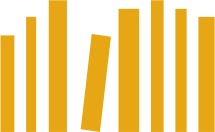Oral language, Letter knowledge
Children will strengthen their comprehension of information presented in a book read aloud and increase the number of novel words they understand. Children will also identify and name the letter W.


New:
Review:
Be Prepared: This is the second of three repeated readings of a book with children. Today’s session focuses on children’s comprehension of information presented in the book, especially connections to children’s experiences. The session also helps children understand more novel words. From the list of novel words you identified prior to your first reading of the book, select 4–6 words to define for children today. Remember, it is okay to select words that a few children may know if you anticipate most children do not understand the word’s meaning. See the Language/Literacy section of the ELM User Guide: 3–5 Years for additional information on how to select and define novel words.
 [Display letter W card.]
[Display letter W card.]
What is the name of this letter?
[Point to the uppercase letter W on the letter card.]
Am I pointing to the uppercase or to the lowercase letter W?
Now let’s spend some time with our book.
[See Week 3, Day 3 of Language/Literacy for a description and examples of how to approach today’s book reading. Key aspects are summarized below:
Measurement knowledge
Children will understand the measurement concepts of foot and inch.


New:
Review:

Inch by Inch by Leo Lionni
Be Prepared: The centimeter lines on a ruler are not part of today’s activity and might be confusing to children as they explore how a ruler shows inches. You may wish to print out and use the provided ruler, which shows inches only.
We are learning how to use a ruler to measure things. Today we will learn more about a ruler and how to measure things with a ruler.
[Display a ruler and point to one end and then the other end.]

The size of a typical ruler from one end to the other end is called a foot.
Why do you think we call the size of this ruler a foot?
Long ago people used their feet to measure things. They would walk toe to heel like this.
[Walk toe to heel and count five “feet.”]
This is how the size of a typical ruler came to be known as a foot. A typical ruler is about the size of an adult’s foot.
Do you think each person’s foot was the same size?
[Encourage children to put the sole of their foot (with shoe on) against the sole of a neighbor’s foot and compare sizes.]
Are our feet the same size?
 Our feet are different sizes. Remember, our hands are different sizes, too. Long ago, people decided to measure things with something that was the same size. They began to use a ruler to measure things instead of their feet.
Our feet are different sizes. Remember, our hands are different sizes, too. Long ago, people decided to measure things with something that was the same size. They began to use a ruler to measure things instead of their feet.
Sometimes when we measure with a ruler, our ruler doesn’t end up exactly at the end of the item we are measuring.
Today we will learn about another part of a ruler that helps us to measure when this happens.
[Give each child a ruler.]
Let’s look closely at our ruler. A ruler has numbers and lines on it. Watch as I point to and count the numbers at the top of my ruler.
[Encourage children to count with you as you point to and count numbers 1–12 on your ruler.]
Now let’s count together the numbers on the top of our ruler. We will begin with the number one. Please point to each number as we count together.
[Lead children in counting the numbers 1–12 on their ruler. Encourage children to point to each numeral as it is counted.
Place one finger on the numeral one and another finger on the numeral two on your ruler.]
The length of the space from one number to the next number is called an inch. Let’s put one finger on the number one and another finger on the number two.
[Help children place their fingers, if necessary.]
The space between both fingers is one inch. Now put one finger on the number two and another finger on the number three.
[Help children place their fingers, if necessary.]
The space between both fingers is also one inch. There are 12 inches on our ruler.
We use the inches on a ruler when our ruler doesn’t end up exactly at the end of the item we are measuring. We can also use the inches on a ruler when we are measuring items that are smaller than one foot. I will show you one way to use inches when measuring.
[Measure a large item that is not an exact number of feet. After measuring the last full foot, measure the remaining length using inches. Point to each inch as you count how many inches in the remainder of the item. When you are finished, say aloud the measurement of the item. Example: “This table is about three feet and six inches long.” Use the word “about” to again signify that the item is close to the number stated if the item is longer or shorter than the last inch measured.]
Now we are going to measure a person with our ruler. When we do this, we will first mark how tall the person is on the wall with tape. Then we will measure the tape to see how many feet and inches tall the person is.
[Invite a volunteer child to stand up against a bare wall. Mark the child’s height on the wall using masking tape. Place the tape on the wall from the floor to the top of the child’s head.]
Now we will use a ruler to measure how tall (child’s name) is.
[Begin measuring by placing the end of the ruler on the floor. Mark with your finger the number of feet as you measure the tape. Say the number of feet aloud as you count; one foot, two feet, three feet, etc. Restate the number of feet you counted. When you are near the top end of the tape, use inches to measure the remaining distance. Say the number of inches aloud as you point to and count each inch; one inch, two inches, three inches, etc. Restate the number of inches you counted.]
We used a ruler and we found that (child’s name) is about __ feet and __ inches tall.
Today we used a ruler to measure how tall (child’s name) is. Who can tell us what we can use to measure when our ruler doesn’t end up exactly at the end of the item we are measuring? (inches)
Extra support
Enrichment
Supply rulers. Encourage children to use a ruler to measure various larger items in your room. Blocks are useful for learning how to measure inches.
Measure larger items while at the playground or at the park. Invite children to help you measure and count the number of feet and inches.
Skills that support creative expression
Children will create dance movements using their arms and legs.


Review:

Be Prepared: Arrange children in their personal spaces so they do not unintentionally hit each other while moving their legs and arms. You may wish to use hoops, tape, or some other way to mark each child’s personal space.
This week we have been choreographers creating different dance movements. Each of us made up movements, first with our arms and then with our legs.
Today we will create dance movements using our legs and our arms. We can do movements we created earlier this week. We also can try different movements. Each of us can do different types of dance movements.
When we invent our dances, we will stay in our own space and try to stay out of other people’s space.
There are different ways we can put leg and arm movements together.
[Demonstrate and describe putting an arm movement and then a leg movement in sequence. Example: “I am moving my arms forward. I am holding my arms out in front of me. Now I am moving one of my legs forward.”]
Let’s practice putting together some arm and leg movements into a dance.
[Encourage children to try several combinations of arm and leg movements. Offer verbal support as appropriate.]
Now I will play the music we listened to when we created dance movements with our arms only; then with our legs only. This time we will use both our arms and legs. Remember, our dance does not need to look like anyone else’s dance.
 [Play part of Track 12 on the My First Classical Music Album CD.]
[Play part of Track 12 on the My First Classical Music Album CD.]
Today we created some dance movements using our arms and our legs. What was it like to dance with more than one part of your body?
Extra support
Enrichment
Provide a CD player, music, and props that children enjoyed using on Days 1 or 2. Encourage children to try different combinations of arm and leg movements.
At pickup time, encourage children to tell family members how they have been a choreographer and to share some of the dance movements they created.
Understanding Feelings
Social-Emotional
Skill and Goal
Emotion knowledge
Children will strengthen their understanding of different emotions.
Materials
Needed
*Printables provided
Key
Concepts
Review:
Also
Promotes
We are learning about many different emotions. What is an emotion? (the way we feel)
We are going to read our book The Way I Feel to remind us of some of the emotions we have talked about.
[Follow-up prompts, if needed: “Why might someone feel _____?” “What might happen to make someone feel _____?”
Point to and identify the pertinent picture on the Our Feelings poster. You may wish to invite a volunteer child to do this for the feelings that are easy to identify on the poster.]
[Display book cover, upside down.]
We talked about many different emotions today. We can try to figure out how people feel by looking at their face and body, and also thinking about what might have happened.
Scaffolding Tips
Extra support
Enrichment
Center Activity
Provide children with the *Our Feelings poster and handheld mirrors. Encourage each child to look at his/her face in the mirror as he/she imitates each expression on the poster.
*Printables provided
Family Child Care
At appropriate points during the day, gently and briefly draw a child’s attention to what he/she may be feeling. Example: “You have a smile on your face, Joshua. Are you happy we are having your favorite snack?”